
FastAPI
FastAPI is a modern, fast (high-performance), web framework for building APIs with Python 3.7+ based on standard Python type hints.
Features:
- Fast
- Fast to Code
- Fewer bugs
- Intuitive
- Easy
- Short
- Robust
- Standard-based
- OpenAPI
- JSON Schema
Requirements
- Python 3.7 +
- Starlette
- Pydantic
Installation
pip3 install -U pip "fastapi[all]" ujson email-validator orjson "uvicorn[standard]"
❯ pip freeze
anyio==3.6.2
click==8.1.3
fastapi==0.88.0
h11==0.14.0
httptools==0.5.0
idna==3.4
pydantic==1.10.2
python-dotenv==0.21.0
PyYAML==6.0
sniffio==1.3.0
starlette==0.22.0
typing_extensions==4.4.0
uvicorn==0.20.0
uvloop==0.17.0
watchfiles==0.18.1
websockets==10.4
Example
Create it
from typing import Union
from fastapi import FastAPI
app = FastAPI()
@app.get("/")
def read_root_sync():
return {"Hello": "World"}
@app.get("/items/{item_id}")
def read_item_sync(item_id: int, q: Union[str, None] = None):
"""
Read a single item synchronously
:param item_id: int
:param q: an optional string query parameter
:return:
"""
return {"item_id": item_id, "q": q}

Example Upgrade
3. Python Types
def get_full_name(first_name: str, last_name: str) -> str:
full_name = first_name.title() + ' ' + last_name.title()
return full_name
print(get_full_name("john", "doe"))

We are using colons (:), not equals (=).
Simple Types
You can use, for example:
intfloatboolbytes
def get_items(item_a: str, item_b: int, item_c: float, item_d: bool, item_e: bytes):
return item_a, item_b, item_c, item_d, item_d, item_e
List
def process_items(items: list[str]):
for item in items:
print(item)
Those internal types in the square brackets are called “type parameters”.
In this case,
stris the type parameter passed tolist
Tuple and Set
def process_items(items_t: tuple[int, int, str], items_s: set[bytes]):
return items_t, items_s
This means:
- The variable
items_tis atuplewith 3 items, anint, anotherint, and astr. - The variable
items_sis aset, and each of its items is of typebytes.
Dict
To define a dict, you pass 2 type parameters, separated by commas.
The first type parameter is for the keys of the dict.
The second type parameter is for the values of the dict:
def process_items(prices: dict[str, float]):
for item_name, item_price in prices.items():
print(item_name)
print(item_price)
Union
You can declare that a variable can be any of several types, for example, an int or a str.
In Python 3.10 there’s also an alternative syntax where you can put the possible types separated by a vertical bar (|).
def process_item(item: int | str):
print(item)
Possibly None
You can declare that a value could have a type, like str, but that it could also be None.
def say_hi(name: str | None = None):
if name is not None:
print(f"Hey {name}!")
else:
print("Hello World")
Generic Types
These types that take type parameters in square brackets are called Generic types or Generics, for example:
You can use the same builtin types as generics (with square brackets and types inside):
listtuplesetdict
you can use the vertical bar (|) to declare unions of types.
Classes as Types
You can also declare a class as the type of a variable.
class Person:
def __init__(self, name: str):
self.name = name
def get_person_name(one_person: Person) -> str:
return one_person.name
p1 = Person(name="Trump")
print(get_person_name(p1))
Pydantic Models
Pydantic is a Python library to perform data validation.
You declare the “shape” of the data as classes with attributes.
And each attribute has a type.
from datetime import datetime
from pydantic import BaseModel
class User(BaseModel):
id: int
name = "John Smith"
signup_ts: datetime | None = None
friends: list[int] = []
external_data = {
"id": "123",
"signup_ts": "2017-06-01 12:22",
"friends": [1, "2", b"3"],
}
user = User(**external_data)
print(user)
print(user.id)

First Steps
When building APIs, you normally use these specific HTTP methods to perform a specific action.
Normally you use:
POST: to create data.GET: to read data.PUT: to update data.DELETE: to delete data.
So, in OpenAPI, each of the HTTP methods is called an “operation”.
We are going to call them “operations” too.
Path parameters
Order matters
Like /users/me, let’s say that it’s to get data about the current user.
And then you can also have a path /users/{user_id} to get data about a specific user by some user ID.
Because path operations are evaluated in order, you need to make sure that the path for /users/me is declared before the one for /users/{user_id}:
Predefined values
class ModelName(str, Enum):
alexnet = "alexnet"
resnet = 'resnet'
lenet = 'lenet'
@app.get("/models/{model_name}")
async def read_model(model_name: ModelName):
if model_name is ModelName.alexnet:
return {"model_name": model_name, "message": "Deep Learning FTW"}
elif model_name.value == 'lenet':
return {"model_name": model_name, "message": "LeCNN all the images"}
return {"model_name": model_name, "message": "Have some residuals"}
Query Parameters
When you declare other function parameters that are not part of the path parameters, they are automatically interpreted as “query” parameters.
fake_items_db = [{"item_name": "Foo"}, {"item_name": "Bar"}, {"item_name": "Baz"}]
@app.get("/items/")
async def read_items_query(skip: int = 0, limit: int = 10):
return fake_items_db[skip:skip + limit]
The query is the set of key-value pairs that go after the ? in a URL, separated by & characters.
For example, in the URL:
http://127.0.0.1:8000/items/?skip=0&limit=10
Defaults of query parameters
As query parameters are not a fixed part of a path, they can be optional and can have default values.
The same way, you can declare optional query parameters, by setting their default to None:
fake_items_db = [{"item_name": "Foo"}, {"item_name": "Bar"}, {"item_name": "Baz"}]
@app.get("/items/")
async def read_items_query(skip: int = 0, limit: int = 10):
return fake_items_db[skip:skip + limit]
@app.get("/items_query/{item_id}")
async def read_item_query(item_id: int, q: str | None = None):
if q:
return {"item_id": item_id, "q": q}
return {"item_id": item_id}
Multiple path and query parameters
You can declare multiple path parameters and query parameters at the same time, FastAPI knows which is which.
And you don’t have to declare them in any specific order.
@app.get("/users/{user_id}/items/{item_id}")
async def read_user_item(user_id: int, item_id: int, q: str | None = None, short: bool = False):
item = {"item_id": item_id, "owner_id": user_id}
if q:
item.update({"q": q})
if not short:
item.update(
{"description": "This is an amazing item that has a long description"}
)
return item
Required query parameters
But when you want to make a query parameter required, you can just not declare any default value:
Request Body
When you need to send data from a client (let’s say, a browser) to your API, you send it as a request body.
A request body is data sent by the client to your API. A response body is the data your API sends to the client.
Your API almost always has to send a response body. But clients don’t necessarily need to send request bodies all the time.
class Item2(BaseModel):
name: str
price: float
description: str | None = None
tax: float | None = None
@app.post("/items2/")
async def create_item(item: Item2):
return item
when a model attribute has a default value, it is not required. Otherwise, it is required. Use
Noneto make it just optional.
{
"name": "Foo",
"description": "An optional description",
"price": 45.2,
"tax": 3.5
}
@app.post("/items2/")
async def create_item(item: Item2):
item_dict = item.dict()
if item.tax:
price_with_tax = item.price + item.tax
item_dict.update({"price_with_tax": price_with_tax})
return item_dict
Request body + path parameters
@app.put("items2/{item_id}")
async def create_item2(item_id: int, item: Item2):
return {"item_id": item_id, **item.dict()}
Request body + path + query parameters
@app.put("/items22/{item_id}")
async def update_item2(item_id: int, item: Item2, q: str | None = None):
result = {"item_id": item_id, **item.dict()}
if q:
result.update({"q": q})
return result
- If the parameter is also declared in the path, it will be used as a path parameter.
- If the parameter is of a singular type (like
int,float,str,bool, etc) it will be interpreted as a query parameter. - If the parameter is declared to be of the type of a Pydantic model, it will be interpreted as a request body.
Query Parameters and String Validators
FastAPI allows you to declare additional information and validation for your parameters.
Optional
@app.get("/items-optional/")
async def read_items_optional(q: str | None = None):
results = {"items": [{"item_id": "Foo"}, {"item_id": "Bar"}]}
if q:
results.update({"q": q})
return results
Additional Validation
We are going to enforce that even though q is optional, whenever it is provided, its length doesn’t exceed 50 characters.
@app.get("/items-optional/")
async def read_items_optional(q: str | None = Query(default=None, max_length=50)):
results = {"items": [{"item_id": "Foo"}, {"item_id": "Bar"}]}
if q:
results.update({"q": q})
return results
Add more validations
You can also add a parameter min_length:
@app.get("/items-optional/")
async def read_items_optional(q: str | None = Query(default=None, min_length=3, max_length=50)):
results = {"items": [{"item_id": "Foo"}, {"item_id": "Bar"}]}
if q:
results.update({"q": q})
return results
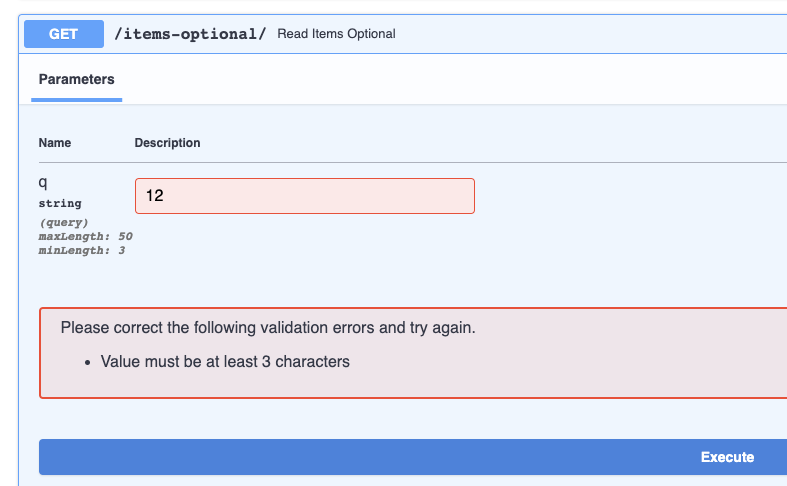
Add regular expressions
@app.get("/items-optional/")
async def read_items_optional(q: str | None = Query(default=None, min_length=3, max_length=50, regex="^fixedquery$")):
results = {"items": [{"item_id": "Foo"}, {"item_id": "Bar"}]}
if q:
results.update({"q": q})
return results
Required
@app.get("/items-required/")
async def read_items_optional(q: str = Query(min_length=3, max_length=50, regex="^fixedquery$")):
results = {"items": [{"item_id": "Foo"}, {"item_id": "Bar"}]}
if q:
results.update({"q": q})
return results
Required with Ellipsis (…)
@app.get("/items-required-ellipsis/")
async def read_items_optional(q: str = Query(default=..., max_length=5)):
results = {"items": [{"item_id": "Foo"}, {"item_id": "Bar"}]}
if q:
results.update({"q": q})
return results
...: it is a special single value, it is part of Python and is called “Ellipsis”.It is used by Pydantic and FastAPI to explicitly declare that a value is required.
Required with None
You can declare that a parameter can accept None, but that it’s still required. This would force clients to send a value, even if the value is None.
To do that, you can declare that None is a valid type but still use default=...:
@app.get("/items/")
async def read_items(q: str | None = Query(default=..., min_length=3)):
results = {"items": [{"item_id": "Foo"}, {"item_id": "Bar"}]}
if q:
results.update({"q": q})
return results
Pydantic Required, instead of Ellipsis(…)
from pydantic import Required
@app.get("/items/")
async def read_items(q: str = Query(default=Required, min_length=3)):
results = {"items": [{"item_id": "Foo"}, {"item_id": "Bar"}]}
if q:
results.update({"q": q})
return results
Query parameter list / multiple value
@app.get("/items-query-list")
async def read_items_query_list(q: list[str] | None = Query(default=None)):
query_items = {"q": q}
return query_items
To declare a query parameter with a type of
list, like in the example above, you need to explicitly useQuery, otherwise it would be interpreted as a request body.
Query parameter list / multiple values with defaults
@app.get("/items/")
async def read_items(q: list[str] = Query(default=["foo", "bar"])):
query_items = {"q": q}
return query_items
using list
@app.get("/items/")
async def read_items(q: list = Query(default=[])):
query_items = {"q": q}
return query_items
Declare more metadata
@app.get("/items-query-metadata")
async def read_items_query_metadata(
q: str | None = Query(
default=None,
title="Query String Title",
description="Query String Description",
min_length=3, )
):
results = {"items": [{"item_id": "foo"}, {"item_id": "bar"}]}
if q:
results.update({"q": q})
return results
Alias parameters
Imagine that you want the parameter to be item-query.
Like in:
http://127.0.0.1:8000/items/?item-query=foobaritems
But item-query is not a valid Python variable name.
@app.get("/items-query-alias")
async def read_items_query_alias(q: str | None = Query(default=None, alias="item-query")):
results = {"items": [{"item_id": "foo"}, {"item_id": "bar"}]}
if q:
results.update({"q": q})
return results

Deprecating parameters
@app.get("/items/")
async def read_items(
q: str
| None = Query(
default=None,
alias="item-query",
title="Query string",
description="Query string for the items to search in the database that have a good match",
min_length=3,
max_length=50,
regex="^fixedquery$",
deprecated=True,
)
):
results = {"items": [{"item_id": "Foo"}, {"item_id": "Bar"}]}
if q:
results.update({"q": q})
return results
Exclude from OpenAPI and automcatic document system
from fastapi import FastAPI, Query
app = FastAPI()
@app.get("/items/")
async def read_items(
hidden_query: str | None = Query(default=None, include_in_schema=False)
):
if hidden_query:
return {"hidden_query": hidden_query}
else:
return {"hidden_query": "Not found"}
Path Parameters and numeric validators
@app.get("/items-path-parameters/{item_id}")
async def read_items_path_parameters(
item_id: int = Path(title="the ID of the item to get"),
q: str | None = Query(default=None, alias="item-query")):
results = {"item_id": item_id}
if q:
results.update({"q": q})
return results
Order the parameters as you need, tricks
If you want to declare the q query parameter without a Query nor any default value, and the path parameter item_id using Path, and have them in a different order, Python has a little special syntax for that.
Pass *, as the first parameter of the function.
Python won’t do anything with that *, but it will know that all the following parameters should be called as keyword arguments (key-value pairs), also known as kwargs. Even if they don’t have a default value.
@app.get("/items/{item_id}")
async def read_items(*, item_id: int = Path(title="The ID of the item to get"), q: str):
results = {"item_id": item_id}
if q:
results.update({"q": q})
return results
Number validations
greater than or equal
@app.get("/items/{item_id}")
async def read_items(
*, item_id: int = Path(title="The ID of the item to get", ge=1), q: str
):
results = {"item_id": item_id}
if q:
results.update({"q": q})
return results
greater than and less than or equal
from fastapi import FastAPI, Path
app = FastAPI()
@app.get("/items/{item_id}")
async def read_items(
*,
item_id: int = Path(title="The ID of the item to get", gt=0, le=1000),
q: str,
):
results = {"item_id": item_id}
if q:
results.update({"q": q})
return results
floats, greater than and less than
@app.get("/items/{item_id}")
async def read_items(
*,
item_id: int = Path(title="The ID of the item to get", ge=0, le=1000),
q: str,
size: float = Query(gt=0, lt=10.5)
):
results = {"item_id": item_id}
if q:
results.update({"q": q})
return results
Body - Multiple Parameters
Mix Path, Query and body parameters
you can also declare body parameters as optional, by setting the default to None:
class Item3(BaseModel):
name: str
description: str | None = None
price: float
tax: float | None = None
@app.put("/items-body/{item_id}")
async def update_item3(
*, # count the parameters as key word parameters
item_id: int = Path(title="the ID of the item to update", ge=0, le=1000),
q: str | None = None,
item: Item3 | None = None,
):
results = {"item_id": item_id}
if q:
results.update({"q": q})
if item:
results.update({"item": item})
return results
Multiple body parameters
class User3(BaseModel):
username: str
full_name: str | None = None
@app.put("/items-body2/{item_id}")
async def update_item3(
*, # count the parameters as key word parameters
item_id: int = Path(title="the ID of the item to update", ge=0, le=1000),
q: str | None = None,
item: Item3,
user: User3,
):
results = {"item_id": item_id}
if q:
results.update({"q": q})
if item:
results.update({"item": item})
return results
Singular values in body
@app.put("/items-importance/{item_id}")
async def update_item(item_id: int, item: Item3, user: User3, importance: int = Body()):
results = {"item_id": item_id, "item": item, "user": user, "importance": importance}
return results
Multiple body params and query
@app.put("/items/{item_id}")
async def update_item(
*,
item_id: int,
item: Item,
user: User,
importance: int = Body(gt=0),
q: str | None = None
):
results = {"item_id": item_id, "item": item, "user": user, "importance": importance}
if q:
results.update({"q": q})
return results
Embed a single body parameter
Let’s say you only have a single item body parameter from a Pydantic model Item.
{
"name": "Foo",
"description": "The pretender",
"price": 42.0,
"tax": 3.2
}
But if you want it to expect a JSON with a key item and inside of it the model contents, as it does when you declare extra body parameters, you can use the special Body parameter embed:
@app.put("/items/{item_id}")
async def update_item(item_id: int, item: Item = Body(embed=True)):
results = {"item_id": item_id, "item": item}
return results
In this case FastAPI will expect a body like:
{
"item": {
"name": "Foo",
"description": "The pretender",
"price": 42.0,
"tax": 3.2
}
}
Body Fields
you can declare validation and metadata inside of Pydantic models using Pydantic’s Field.
class Item4(BaseModel):
name: str
description: str | None = Field(
default=None,
title="The description of the item",
max_length=300
)
price: float
tax: float | None = None
Declare model attributes
You can then use Field with model attributes:
class Item4(BaseModel):
name: str
description: str | None = Field(
default=None,
title="The description of the item",
max_length=300
)
price: float = Field(gt=0, description="The price must be greater than 0")
tax: float | None = None
@app.put("/items4/{item_id}")
async def update_item4(item_id: int, item: Item4 = Body(embed=True)):
results = {"item_id": item_id, "item": item}
return results
Body - Nested Models
With FastAPI, you can define, validate, document, and use arbitrarily deeply nested models (thanks to Pydantic).
List Fields
You can define an attribute to be a subtype. For example, a Python list:
class Item5(BaseModel):
name: str
description: str | None = None
price: float
tax: float | None = None
tags: list = []
@app.put("/items5/{item_id}")
async def update_item(item_id: int, item: Item5):
results = {"item_id": item_id, "item": item}
return results
Declare a list with a type parameter
class Item(BaseModel):
name: str
description: str | None = None
price: float
tax: float | None = None
tags: list[str] = []
Set types
But then we think about it, and realize that tags shouldn’t repeat, they would probably be unique strings.
And Python has a special data type for sets of unique items, the set.
class Item(BaseModel):
name: str
description: str | None = None
price: float
tax: float | None = None
tags: set[str] = set()
// request body
{
"name": "string",
"description": "string",
"price": 0,
"tax": 0,
"tags": [1,2,3,1]
}
// response body
{
"item_id": 5,
"item": {
"name": "string",
"description": "string",
"price": 0,
"tax": 0,
"tags": [
"2",
"1",
"3"
]
}
}
Nested Models
Each attribute of a Pydantic model has a type.
But that type can itself be another Pydantic model.
So, you can declare deeply nested JSON “objects” with specific attribute names, types and validations.
All that, arbitrarily nested.
class Image(BaseModel):
url: str
name: str
class Item6(BaseModel):
name: str
description: str | None = None
price: float
tax: float | None = None
tags: set[str] = set()
image: Image | None = None
Special types and validation
For example, as in the Image model we have a url field, we can declare it to be instead of a str, a Pydantic’s HttpUrl:
from pydantic import BaseModel, HttpUrl
class Image(BaseModel):
url: HttpUrl
name: str
{
"name": "string",
"description": "string",
"price": 0,
"tax": 0,
"tags": [],
"image": {
"url": "https",
"name": "string"
}
}
{
"detail": [
{
"loc": [
"body",
"image",
"url"
],
"msg": "invalid or missing URL scheme",
"type": "value_error.url.scheme"
}
]
}
Attributes with lists of submodels
You can also use Pydantic models as subtypes of list, set, etc:
class Item7(BaseModel):
name: str
description: str | None = None
price: float
tax: float | None = None
tags: set[str] = set()
images: list[Image] | None = None
Deeply nested models
class Offer(BaseModel):
name: str
description: str | None = None
price: float
items: list[Item]
Item nested images, and Offer nested Item
Bodies of pure lists
If the top level value of the JSON body you expect is a JSON array (a Python list), you can declare the type in the parameter of the function, the same as in Pydantic models:
@app.post("/images/multiple/")
async def create_multiple_images(images: list[Image]):
return images
Bodies of arbitrary dicts
You can also declare a body as a dict with keys of some type and values of other type.
Without having to know beforehand what are the valid field/attribute names (as would be the case with Pydantic models).
This would be useful if you want to receive keys that you don’t already know.
Other useful case is when you want to have keys of other type, e.g. int.
That’s what we are going to see here.
In this case, you would accept any dict as long as it has int keys with float values:
@app.post("/index-weights/")
async def create_index_weights(weights: dict[int, float]):
return weights
{ "1" : 3.44 }
curl -X 'POST' \
'http://127.0.0.1:8000/index-weights/' \
-H 'accept: application/json' \
-H 'Content-Type: application/json' \
-d '{
"1": 3.14,
}'
Declare Request Example Data
You can declare examples of the data your app can receive.
Pydantic schema_extra
class Item8(BaseModel):
name: str
description: str | None = None
price: float
tax: float | None = None
class Config:
schema_extra = {
"example": {
"name": "example",
"description": "example description",
"price": 10.0,
"tax": 3.34
}
}
@app.put("/items8/{item_id}")
async def update_item8(item_id: int, item: Item8):
results = {"item_id": item_id, "item": item}
return results

Field additional arguments
When using Field() with Pydantic models, you can also declare extra info for the JSON Schema by passing any other arbitrary arguments to the function.
You can use this to add example for each field:
from pydantic import BaseModel, Field
class Item9(BaseModel):
name: str = Field(example="Foo")
description: str | None = Field(default=None, example="A very nice Item")
price: float = Field(example=35.4)
tax: float | None = Field(default=None, example=3.2)

example and examples in OpenAPI¶
When using any of:
Path()Query()Header()Cookie()Body()Form()File()
you can also declare a data example or a group of examples with additional information that will be added to OpenAPI.
Body with example
@app.put("/items/{item_id}")
async def update_item(
item_id: int,
item: Item = Body(
example={
"name": "Foo",
"description": "A very nice Item",
"price": 35.4,
"tax": 3.2,
},
),
):
results = {"item_id": item_id, "item": item}
return results
Body with multiple examples
Alternatively to the single example, you can pass examples using a dict with multiple examples, each with extra information that will be added to OpenAPI too.
@app.put("/items/{item_id}")
async def update_item(
*,
item_id: int,
item: Item = Body(
examples={
"normal": {
"summary": "A normal example",
"description": "A **normal** item works correctly.",
"value": {
"name": "Foo",
"description": "A very nice Item",
"price": 35.4,
"tax": 3.2,
},
},
"converted": {
"summary": "An example with converted data",
"description": "FastAPI can convert price `strings` to actual `numbers` automatically",
"value": {
"name": "Bar",
"price": "35.4",
},
},
"invalid": {
"summary": "Invalid data is rejected with an error",
"value": {
"name": "Baz",
"price": "thirty five point four",
},
},
},
),
):
results = {"item_id": item_id, "item": item}
return results
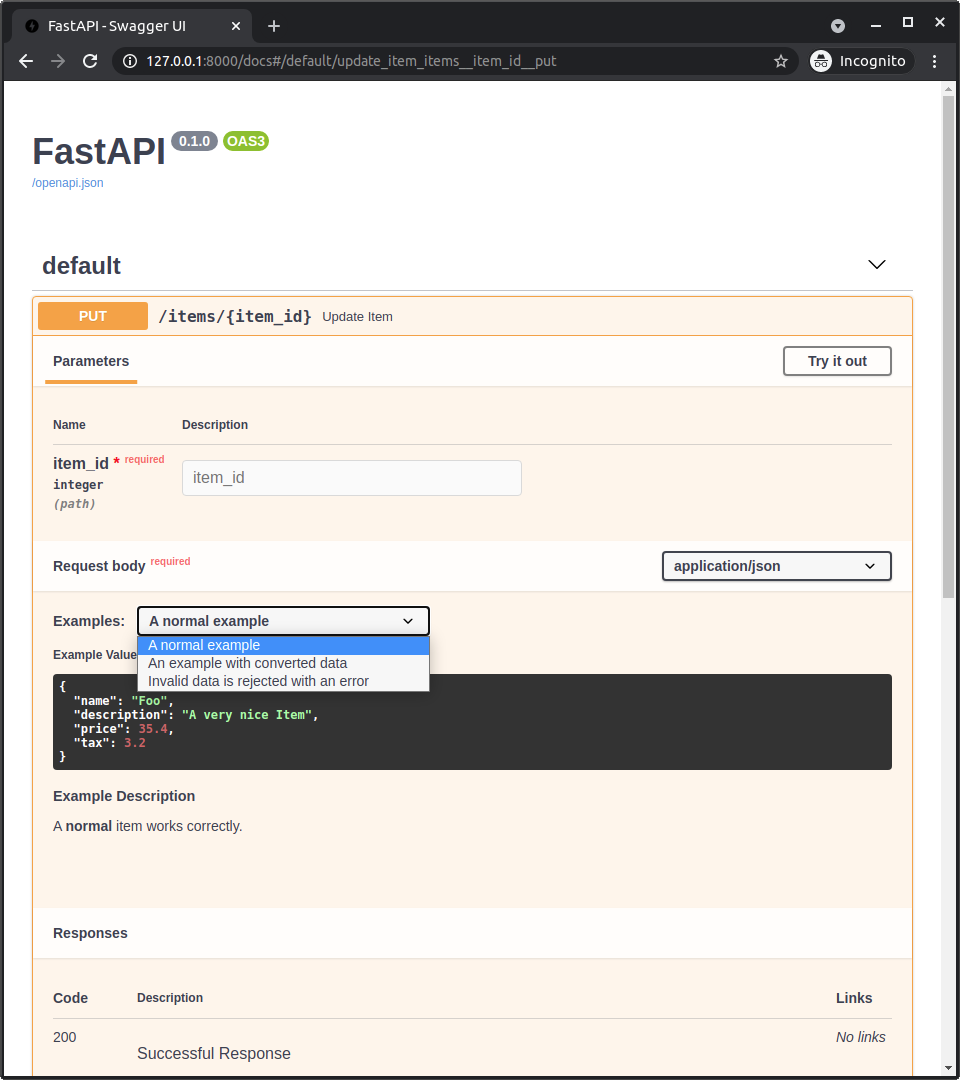
Extra Data Types
common data types, like:
intfloatstrbool
Other data types
Here are some of the additional data types you can use:
-
UUID:
- A standard “Universally Unique Identifier”, common as an ID in many databases and systems.
- In requests and responses will be represented as a
str.
-
datetime.datetime:
- A Python
datetime.datetime. - In requests and responses will be represented as a
strin ISO 8601 format, like:2008-09-15T15:53:00+05:00.
- A Python
-
datetime.date:
- Python
datetime.date. - In requests and responses will be represented as a
strin ISO 8601 format, like:2008-09-15.
- Python
-
datetime.time:
- A Python
datetime.time. - In requests and responses will be represented as a
strin ISO 8601 format, like:14:23:55.003.
- A Python
-
datetime.timedelta:
- A Python
datetime.timedelta. - In requests and responses will be represented as a
floatof total seconds. - Pydantic also allows representing it as a “ISO 8601 time diff encoding”, see the docs for more info.
- A Python
-
frozenset:
-
In requests and responses, treated the same as a
set:
- In requests, a list will be read, eliminating duplicates and converting it to a
set. - In responses, the
setwill be converted to alist. - The generated schema will specify that the
setvalues are unique (using JSON Schema’suniqueItems).
- In requests, a list will be read, eliminating duplicates and converting it to a
-
-
bytes:
- Standard Python
bytes. - In requests and responses will be treated as
str. - The generated schema will specify that it’s a
strwithbinary“format”.
- Standard Python
-
Decimal:
- Standard Python
Decimal. - In requests and responses, handled the same as a
float.
- Standard Python
- You can check all the valid pydantic data types here: Pydantic data types.
@app.put("/items10/{item_id}")
async def read_items(
item_id: UUID,
start_datetime: datetime | None = Body(default=None),
end_datetime: datetime | None = Body(default=None),
repeat_at: time | None = Body(default=None),
process_after: timedelta | None = Body(default=None),
):
start_process = start_datetime + process_after
duration = end_datetime - start_process
return {
"item_id": item_id,
"start_datetime": start_datetime,
"end_datetime": end_datetime,
"repeat_at": repeat_at,
"process_after": process_after,
"start_process": start_process,
"duration": duration,
}
Cookie Parameters
You can define Cookie parameters the same way you define Query and Path parameters.
@app.get("/items11/")
async def read_items11(ads_id: str | None = Cookie(default=None)):
print(ads_id)
return {"ads_id": ads_id}
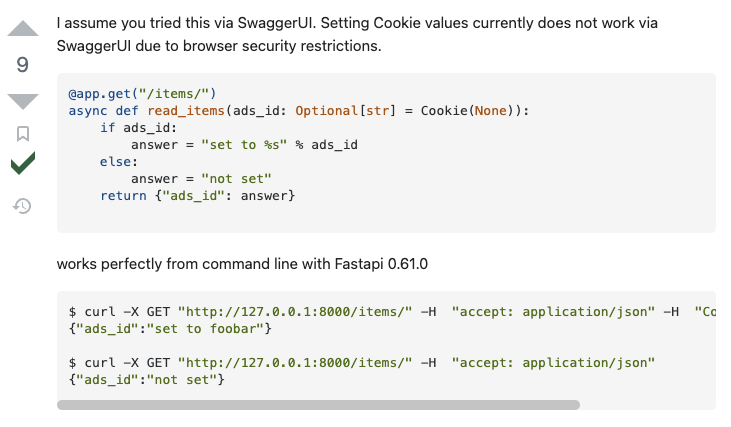
Header Parameters
You can define Header parameters the same way you define Query, Path and Cookie parameters.
@app.get("/header/")
async def read_header(user_agent: str | None = Header(default=None)):
return {"User-Agent": user_agent}
{
"User-Agent": "Mozilla/5.0 (Macintosh; Intel Mac OS X 10_15_7) AppleWebKit/537.36 (KHTML, like Gecko) Chrome/108.0.0.0 Safari/537.36"
}
Header has a little extra functionality on top of what Path, Query and Cookie provide.
Most of the standard headers are separated by a “hyphen” character, also known as the “minus symbol” (-).
But a variable like user-agent is invalid in Python.
So, by default, Header will convert the parameter names characters from underscore (_) to hyphen (-) to extract and document the headers.
Also, HTTP headers are case-insensitive, so, you can declare them with standard Python style (also known as “snake_case”).
So, you can use user_agent as you normally would in Python code, instead of needing to capitalize the first letters as User_Agent or something similar.
It is possible to receive duplicate headers. That means, the same header with multiple values.
You can define those cases using a list in the type declaration.
You will receive all the values from the duplicate header as a Python list.
@app.get("/header/")
async def read_header(user_agent: str | None = Header(default=None), x_token: str | None = Header(default=None)):
return {"User-Agent": user_agent, "X-Token Values": x_token}
Response Model
You can declare the model used for the response with the parameter response_model in any of the path operations:
@app.get()@app.post()@app.put()@app.delete()
Notice that
response_modelis a parameter of the “decorator” method (get,post, etc). Not of your path operation function, like all the parameters and body.
@app.get("/response_body/", response_model=Item8)
async def read_response_body():
return {"item_id": 1, "name": "Foo", "description": "A very nice Item", "price": 10.0, "tax": 3.34}
class UserIn(BaseModel):
username: str
email: EmailStr
password: SecretStr
full_name: str | None = None
class UserOut(BaseModel):
username: str
email: EmailStr
full_name: str | None = None
@app.post("/users/", response_model=UserOut)
async def create_user(user: UserIn):
return user
class Item(BaseModel):
name: str
description: str | None = None
price: float
tax: float = 10.5
items = {
"foo": {"name": "Foo", "price": 50.2},
"bar": {"name": "Bar", "description": "The Bar fighters", "price": 62, "tax": 20.2},
"baz": {
"name": "Baz",
"description": "There goes my baz",
"price": 50.2,
"tax": 10.5,
},
}
@app.get(
"/items/{item_id}/name",
response_model=Item,
response_model_include={"name", "description"},
)
async def read_item_name(item_id: str):
return items[item_id]
@app.get("/items/{item_id}/public", response_model=Item, response_model_exclude={"tax"})
async def read_item_public_data(item_id: str):
return items[item_id]
@app.get("/items/{item_id}", response_model=Item, response_model_exclude_unset=True)
async def read_item(item_id: str):
return items[item_id]
You can also use:
response_model_exclude_defaults=Trueresponse_model_exclude_none=Trueas described in the Pydantic docs for
exclude_defaultsandexclude_none.
Extra Models
Continuing with the previous example, it will be common to have more than one related model.
This is especially the case for user models, because:
- The input model needs to be able to have a password.
- The output model should not have a password.
- The database model would probably need to have a hashed password.
class UserBase(BaseModel):
username: str
email: EmailStr
full_name: str | None = None
class UserIn(UserBase):
password: str
class UserOut(UserBase):
pass
class UserInDB(UserBase):
hashed_password: str
def fake_password_hasher(raw_password: str):
return "supersecret" + raw_password
def fake_save_user(user_in: UserIn):
hashed_password = fake_password_hasher(user_in.password)
user_in_db = UserInDB(**user_in.dict(), hashed_password=hashed_password)
print("User saved! ..not really")
return user_in_db
@app.post("/users-extra/", response_model=UserOut)
async def create_user(user_in: UserIn):
user_saved = fake_save_user(user_in)
print(user_saved)
return user_saved
curl -X 'POST' \
'http://127.0.0.1:8000/users-extra/' \
-H 'accept: application/json' \
-H 'Content-Type: application/json' \
-d '{
"username": "string",
"email": "[email protected]",
"full_name": "string",
"password": "string"
}'
response
{
"username": "string",
"email": "[email protected]",
"full_name": "string"
}

Union or anyOf
You can declare a response to be the Union of two types, that means, that the response would be any of the two.
It will be defined in OpenAPI with anyOf.
class BaseItem(BaseModel):
description: str
type: str
class CarItem(BaseItem):
type = "car"
class PlaneItem(BaseItem):
type = "plane"
size: int
items = {
"item1": {"description": "All my friends drive a low rider", "type": "car"},
"item2": {
"description": "Music is my aeroplane, it's my aeroplane",
"type": "plane",
"size": 5,
},
}
@app.get("/items/{item_id}", response_model=Union[PlaneItem, CarItem])
async def read_item(item_id: str):
return items[item_id]
List of models
@app.get("/items/", response_model=list[Item])
async def read_items():
return items
Response with arbitrary dict
@app.get("/keyword-weights/", response_model=dict[str, float])
async def read_keyword_weights():
return {"foo": 2.3, "bar": 3.4}
Response Status Code
@app.post("/items/", status_code=201)
async def create_item(name: str):
return {"name": name}
In short:
-
100and above are for “Information”. You rarely use them directly. Responses with these status codes cannot have a body. -
200and above are for “Successful” responses. These are the ones you would use the most.
200is the default status code, which means everything was “OK”.- Another example would be
201, “Created”. It is commonly used after creating a new record in the database. - A special case is
204, “No Content”. This response is used when there is no content to return to the client, and so the response must not have a body.
-
300and above are for “Redirection”. Responses with these status codes may or may not have a body, except for304, “Not Modified”, which must not have one. -
400and above are for “Client error” responses. These are the second type you would probably use the most.
- An example is
404, for a “Not Found” response. - For generic errors from the client, you can just use
400.
- An example is
-
500and above are for server errors. You almost never use them directly. When something goes wrong at some part in your application code, or server, it will automatically return one of these status codes.
Form Data
When you need to receive form fields instead of JSON, you can use Form.
To use forms, first install python-multipart.
E.g. pip install python-multipart.
For example, in one of the ways the OAuth2 specification can be used (called “password flow”) it is required to send a username and password as form fields.
The spec requires the fields to be exactly named username and password, and to be sent as form fields, not JSON.
Data from forms is normally encoded using the “media type”
application/x-www-form-urlencoded.But when the form includes files, it is encoded as
multipart/form-data. You’ll read about handling files in the next chapter.
@app.post("/login/")
async def login(username: str = Form(), password: str = Form()):
return {"username": username}
Request Files
pip install python-multipart
@app.post("/files/")
async def create_file(file: bytes = File()):
# whole content will be saved in the memory as bytes
print(file)
return {"file_size": len(file)}
@app.post("/uploadfile/")
async def create_upload_file(file: UploadFile):
contents = await file.read()
print(contents)
return {"filename": file.filename, "content_type": file.content_type, "file": file}
{
"filename": "CleanShot 2022-12-05 at 10.32.57.png",
"content_type": "image/png",
"file": {
"filename": "CleanShot 2022-12-05 at 10.32.57.png",
"content_type": "image/png",
"file": {},
"headers": {
"content-disposition": "form-data; name=\"file\"; filename=\"CleanShot 2022-12-05 at 10.32.57.png\"",
"content-type": "image/png"
}
}
}
UploadFile¶ UploadFile has the following attributes:
filename: A str with the original file name that was uploaded (e.g. myimage.jpg).
content_type: A str with the content type (MIME type / media type) (e.g. image/jpeg).
file: A SpooledTemporaryFile (a file-like object). This is the actual Python file that you can pass directly to other functions or libraries that expect a “file-like” object.
UploadFile has the following async methods. They all call the corresponding file methods underneath (using the internal SpooledTemporaryFile).
write(data): Writes data (str or bytes) to the file.
read(size): Reads size (int) bytes/characters of the file.
seek(offset): Goes to the byte position offset (int) in the file.
E.g., await myfile.seek(0) would go to the start of the file.
This is especially useful if you run await myfile.read() once and then need to read the contents again.
close(): Closes the file.
As all these methods are async methods, you need to “await” them.
For example, inside of an async path operation function you can get the contents with:
contents = await myfile.read()
If you are inside of a normal def path operation function, you can access the UploadFile.file directly, for example:
contents = myfile.file.read()
Optional File Upload
@app.post("/files/")
async def create_file(file: bytes | None = File(default=None, description="A file read as bytes")):
# whole content will be saved in the memory as bytes
if not file:
return {"message": "No file sent"}
else:
return {"file_size": len(file)}
@app.post("/uploadfile/")
async def create_upload_file(file: UploadFile | None = File(default=None, description="A file read as UploadFile")):
if not file:
return {"message": "No upload file sent"}
else:
contents = await file.read()
print(contents)
return {"filename": file.filename, "content_type": file.content_type, "file": file}
Multiple File Uploads
@app.post("/multi-files/")
async def create_multi_files(files: list[bytes] = File(description="Multiple files as bytes")):
return {"file_sizes": [len(file) for file in files]}
@app.post("/upload-multiple-files/")
async def create_upload_files2(files: list[UploadFile] = File(description="Multiple upload files as UploadFile")):
return {"filenames": [file.filename for file in files]}
Request Forms and Files
@app.post("/token-files/")
async def create_file(
file: bytes = File(), fileb: UploadFile = File(), token: str = Form()
):
return {
"file_size": len(file),
"token": token,
"fileb_content_type": fileb.content_type,
}
curl -X 'POST' \
'http://127.0.0.1:8000/token-files/' \
-H 'accept: application/json' \
-H 'Content-Type: multipart/form-data' \
-F 'file=@CleanShot 2022-12-05 at 10.32.57.png;type=image/png' \
-F 'fileb=@CleanShot 2022-12-05 at 10.32.57.png;type=image/png' \
-F 'token=1111'
{
"file_size": 19851,
"token": "1111",
"fileb_content_type": "image/png"
}
Path Operation Configuration
Tags
@app.post("/items/", response_model=Item, tags=["items"])
async def create_item(item: Item):
return item
@app.get("/items/", tags=["items"])
async def read_items():
return [{"name": "Foo", "price": 42}]
@app.get("/users/", tags=["users"])
async def read_users():
return [{"username": "johndoe"}]
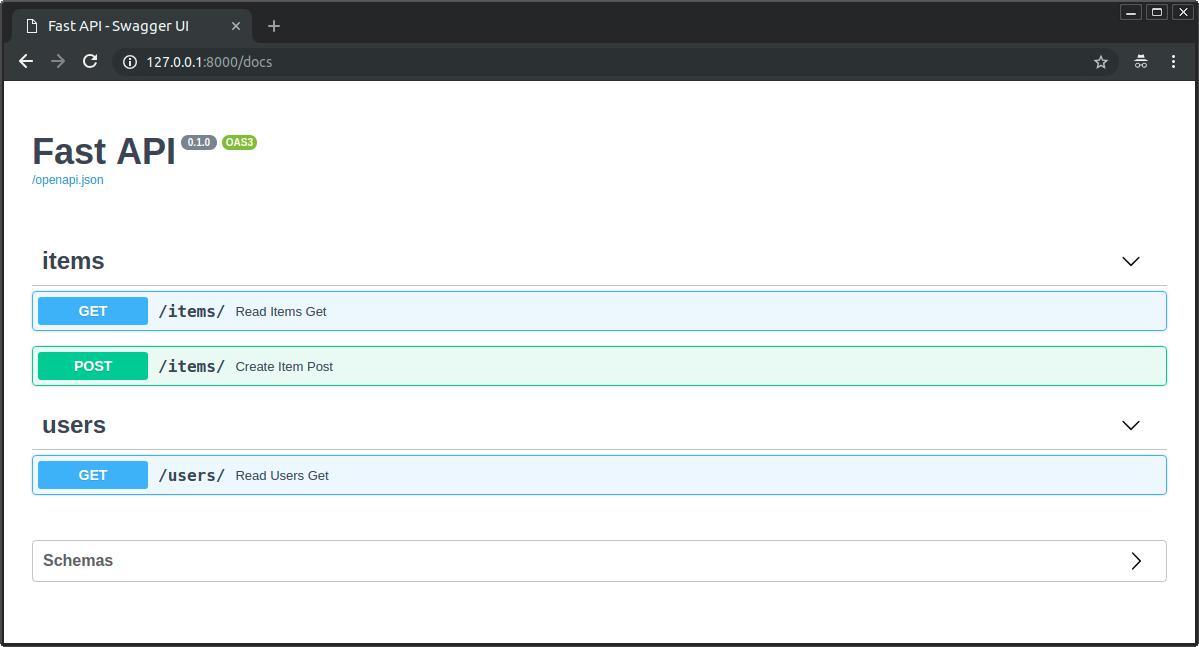
Tags with Enums
class Tags(Enum):
items = "items"
users = "users"
@app.get("/items/", tags=[Tags.items])
async def get_items():
return ["Portal gun", "Plumbus"]
@app.get("/users/", tags=[Tags.users])
async def read_users():
return ["Rick", "Morty"]
Description from docstring
@app.post("/items/", response_model=Item, summary="Create an item")
async def create_item(item: Item):
"""
Create an item with all the information:
- **name**: each item must have a name
- **description**: a long description
- **price**: required
- **tax**: if the item doesn't have tax, you can omit this
- **tags**: a set of unique tag strings for this item
"""
return item
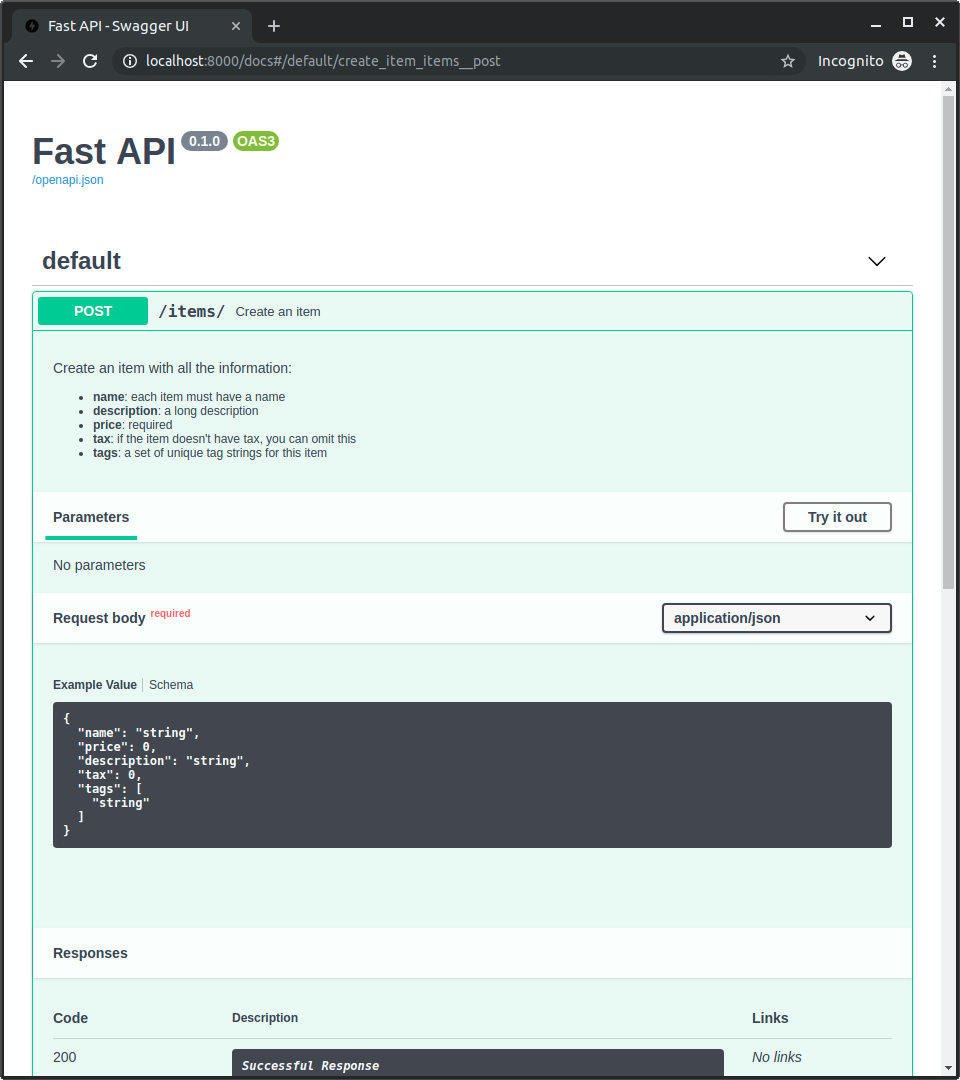
Deprecated
@app.get("/elements/", tags=["items"], deprecated=True)
async def read_elements():
return [{"item_id": "Foo"}]
JSON Compatible Encoder
There are some cases where you might need to convert a data type (like a Pydantic model) to something compatible with JSON (like a dict, list, etc).
For example, if you need to store it in a database.
Let’s imagine that you have a database fake_db that only receives JSON compatible data.
For example, it doesn’t receive datetime objects, as those are not compatible with JSON.
from fastapi.encoders import jsonable_encoder
@app.put("/items/{id}")
def update_item(id: str, item: Item):
json_compatible_item_data = jsonable_encoder(item)
fake_db[id] = json_compatible_item_data
Body Updates (PUT or PATCH)
class Item(BaseModel):
name: str | None = None
description: str | None = None
price: float | None = None
tax: float = 10.5
tags: list[str] = []
items = {
"foo": {"name": "Foo", "price": 50.2},
"bar": {"name": "Bar", "description": "The bartenders", "price": 62, "tax": 20.2},
"baz": {"name": "Baz", "description": None, "price": 50.2, "tax": 10.5, "tags": []},
}
@app.get("/items/{item_id}", response_model=Item)
async def read_item(item_id: str):
return items[item_id]
@app.patch("/items/{item_id}", response_model=Item)
async def update_item(item_id: str, item: Item):
stored_item_data = items[item_id]
stored_item_model = Item(**stored_item_data)
update_data = item.dict(exclude_unset=True)
updated_item = stored_item_model.copy(update=update_data)
items[item_id] = jsonable_encoder(updated_item)
return updated_item
Dependencies
FastAPI has a very powerful but intuitive Dependency Injection system.
“Dependency Injection” means, in programming, that there is a way for your code (in this case, your path operation functions) to declare things that it requires to work and use: “dependencies”.
And then, that system (in this case FastAPI) will take care of doing whatever is needed to provide your code with those needed dependencies (“inject” the dependencies).
This is very useful when you need to:
- Have shared logic (the same code logic again and again).
- Share database connections.
- Enforce security, authentication, role requirements, etc.
- And many other things…
All these, while minimizing code repetition.
async def common_parameters(q: str | None = None, skip: int = 0, limit: int = 100):
return {"q": q, "skip": skip, "limit": limit}
@app.get("/items-depends/")
async def read_items(commons: dict = Depends(common_parameters)):
return commons
@app.get("/users-depends/")
async def read_users(commons: dict = Depends(common_parameters)):
return commons
- Calling your dependency (“dependable”) function with the correct parameters.
- Get the result from your function.
- Assign that result to the parameter in your path operation function.
With the Dependency Injection system, you can also tell FastAPI that your path operation function also “depends” on something else that should be executed before your path operation function, and FastAPI will take care of executing it and “injecting” the results.
Other common terms for this same idea of “dependency injection” are:
- resources
- providers
- services
- injectables
- components
For example, let’s say you have 4 API endpoints (path operations):
/items/public//items/private//users/{user_id}/activate/items/pro/
then you could add different permission requirements for each of them just with dependencies and sub-dependencies:

Classes as Dependencies
The key factor is that a dependency should be a “callable”.
A “callable” in Python is anything that Python can “call” like a function.
class CommonQueryParams:
def __init__(self, q: str | None = None, skip: int = 0, limit: int = 100):
self.q = q
self.skip = skip
self.limit = limit
@app.get("/items-common-depends/")
async def read_items(commons: CommonQueryParams = Depends()):
response = {}
if commons.q:
response.update({"q": commons.q})
items = fake_items_db[commons.skip: commons.skip + commons.limit]
response.update({"items": items})
return response
Sub-dependencies
You can create dependencies that have sub-dependencies.
def query_extractor(q: str | None = None):
return q
def query_or_cookie_extractor(
q: str = Depends(query_extractor), last_query: str | None = Cookie(default=None)
):
# If the user didn't provide any query q, we use the last query used, which we saved to a cookie before.
if not q:
return last_query
return q
@app.get("/items12/")
async def read_query(query_or_default: str = Depends(query_or_cookie_extractor)):
return {"q_or_cookie": query_or_default}
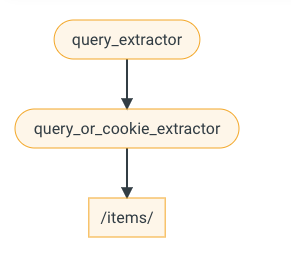

Dependencies in path operation decorators
In some cases you don’t really need the return value of a dependency inside your path operation function.
Or the dependency doesn’t return a value.
But you still need it to be executed/solved.
For those cases, instead of declaring a path operation function parameter with Depends, you can add a list of dependencies to the path operation decorator.
async def verify_token(x_token: str = Header()):
if x_token != "fake-super-secret-token":
raise HTTPException(status_code=400, detail="X-Token header invalid")
async def verify_key(x_key: str = Header()):
if x_key != "fake-super-secret-key":
raise HTTPException(status_code=400, detail="X-Key header invalid")
return x_key
@app.get("/items12/", dependencies=[Depends(verify_token), Depends(verify_key)])
async def read_items():
return [{"item": "Foo"}, {"item": "Bar"}]
Global Dependency
app = FastAPI(dependencies=[Depends(verify_token), Depends(verify_key)])
Dependency with Yield
FastAPI supports dependencies that do some extra steps after finishing.
To do this, use yield instead of return, and write the extra steps after.
Any function that is valid to use with:
would be valid to use as a FastAPI dependency.
In fact, FastAPI uses those two decorators internally.
If you use a try block in a dependency with yield, you’ll receive any exception that was thrown when using the dependency.
async def get_db():
db = DBSession()
try:
yield db
finally:
db.close()
Sub Dependency with Yield
FastAPI will make sure that the “exit code” in each dependency with yield is run in the correct order.
For example, dependency_c can have a dependency on dependency_b, and dependency_b on dependency_a:
async def dependency_a():
dep_a = generate_dep_a()
try:
yield dep_a
finally:
dep_a.close()
async def dependency_b(dep_a=Depends(dependency_a)):
dep_b = generate_dep_b()
try:
yield dep_b
finally:
dep_b.close(dep_a)
async def dependency_c(dep_b=Depends(dependency_b)):
dep_c = generate_dep_c()
try:
yield dep_c
finally:
dep_c.close(dep_b)
sequenceDiagram
participant client as Client
participant handler as Exception handler
participant dep as Dep with yield
participant operation as Path Operation
participant tasks as Background tasks
Note over client,tasks: Can raise exception for dependency, handled after response is sent
Note over client,operation: Can raise HTTPException and can change the response
client ->> dep: Start request
Note over dep: Run code up to yield
opt raise
dep -->> handler: Raise HTTPException
handler -->> client: HTTP error response
dep -->> dep: Raise other exception
end
dep ->> operation: Run dependency, e.g. DB session
opt raise
operation -->> dep: Raise HTTPException
dep -->> handler: Auto forward exception
handler -->> client: HTTP error response
operation -->> dep: Raise other exception
dep -->> handler: Auto forward exception
end
operation ->> client: Return response to client
Note over client,operation: Response is already sent, can't change it anymore
opt Tasks
operation -->> tasks: Send background tasks
end
opt Raise other exception
tasks -->> dep: Raise other exception
end
Note over dep: After yield
opt Handle other exception
dep -->> dep: Handle exception, can't change response. E.g. close DB session.
end
Context Managers
“Context Managers” are any of those Python objects that you can use in a with statement.
For example, you can use with to read a file:
with open("./somefile.txt") as f:
contents = f.read()
print(contents)
Underneath, the open("./somefile.txt") creates an object that is a called a “Context Manager”.
When the with block finishes, it makes sure to close the file, even if there were exceptions.
In Python, you can create Context Managers by creating a class with two methods: __enter__() and __exit__().
class MySuperContextManager:
def __init__(self):
self.db = DBSession()
def __enter__(self):
return self.db
def __exit__(self, exc_type, exc_value, traceback):
self.db.close()
async def get_db():
with MySuperContextManager() as db:
yield db
Security
There are many ways to handle security, authentication and authorization.
To put it simply, authentication is about who you are, while authorization is about what you are allowed to do.
OAuth2¶
OAuth2 is a specification that defines several ways to handle authentication and authorization.
It is quite an extensive specification and covers several complex use cases.
It includes ways to authenticate using a “third party”.
That’s what all the systems with “login with Facebook, Google, Twitter, GitHub” use underneath.
OpenID Connect is another specification, based on OAuth2.
It just extends OAuth2 specifying some things that are relatively ambiguous in OAuth2, to try to make it more interoperable.
OpenAPI (previously known as Swagger) is the open specification for building APIs (now part of the Linux Foundation).
FastAPI is based on OpenAPI.
OpenAPI defines the following security schemes:
apiKey: an application specific key that can come from:- A query parameter.
- A header.
- A cookie.
http: standard HTTP authentication systems, including:bearer: a headerAuthorizationwith a value ofBearerplus a token. This is inherited from OAuth2.- HTTP Basic authentication.
- HTTP Digest, etc.
oauth2: all the OAuth2 ways to handle security (called “flows”).- Several of these flows are appropriate for building an OAuth 2.0 authentication provider (like Google, Facebook, Twitter, GitHub, etc):
implicitclientCredentialsauthorizationCode
- But there is one specific “flow” that can be perfectly used for handling authentication in the same application directly:
password: some next chapters will cover examples of this.
- Several of these flows are appropriate for building an OAuth 2.0 authentication provider (like Google, Facebook, Twitter, GitHub, etc):
openIdConnect: has a way to define how to discover OAuth2 authentication data automatically.- This automatic discovery is what is defined in the OpenID Connect specification.
username and password
oauth2_scheme = OAuth2PasswordBearer(tokenUrl="token")
@app.get("/items13/")
async def read_items(token: str = Depends(oauth2_scheme)):
return {"token": token}

OAuth2 was designed so that the backend or API could be independent of the server that authenticates the user.
But in this case, the same FastAPI application will handle the API and the authentication.
-
A “token” is just a string with some content that we can use later to verify this user.
-
Normally, a token is set to expire after some time.
- So, the user will have to log in again at some point later.
- And if the token is stolen, the risk is less. It is not like a permanent key that will work forever (in most of the cases).
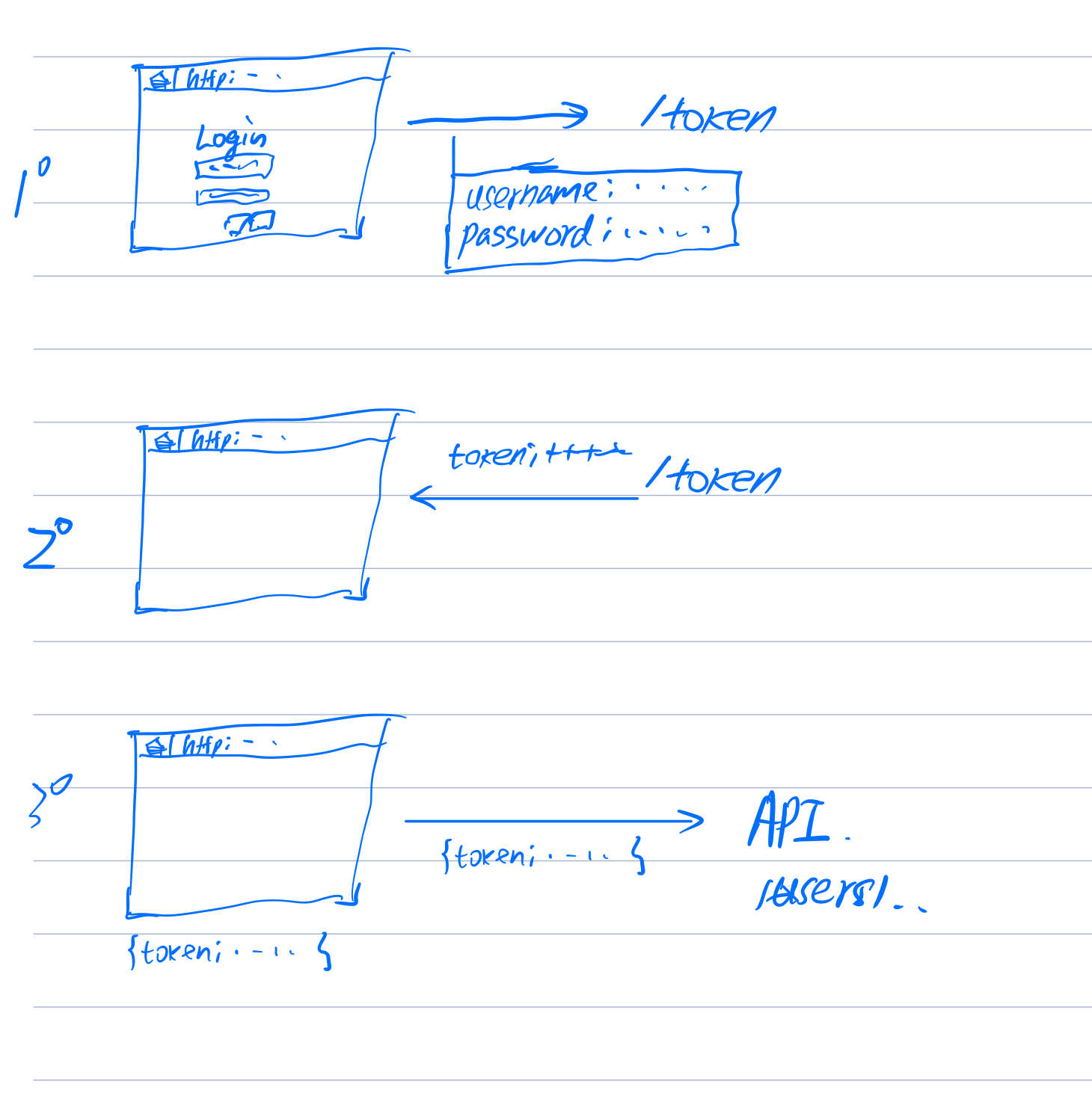
When we create an instance of the OAuth2PasswordBearer class we pass in the tokenUrl parameter. This parameter contains the URL that the client (the frontend running in the user’s browser) will use to send the username and password in order to get a token.
oauth2_scheme = OAuth2PasswordBearer(tokenUrl="token")
# tokenUrl="token" refers to a relative URL token, it's equivalent to ./token
@app.get("/items13/")
async def read_items(token: str = Depends(oauth2_scheme)):
# This dependency will provide a str that is assigned to the parameter token of the path operation function.
return {"token": token}
Get current user
class User4(BaseModel):
username: str
email: str | None = None
full_name: str | None = None
disabled: bool | None = None
def fake_decode_token(token):
user = User4(
username=token + "fake_decoded",
email="[email protected]",
full_name="John Doe",
disabled=False
)
print(user)
return user
async def get_current_user(token: str = Depends(oauth2_scheme)):
print(token)
user = fake_decode_token(token)
print(user)
return user
@app.get("/users-token/me")
async def read_users_me(current_user: User4 = Depends(get_current_user)):
return current_user
Simple OAuth2 with Password and Bearer
OAuth2 specifies that when using the “password flow” (that we are using) the client/user must send a username and password fields as form data.
scope¶
The spec also says that the client can send another form field “scope”.
The spec also says that the client can send another form field “scope”.
The form field name is scope (in singular), but it is actually a long string with “scopes” separated by spaces.
Each “scope” is just a string (without spaces).
They are normally used to declare specific security permissions, for example:
users:readorusers:writeare common examples.instagram_basicis used by Facebook / Instagram.https://www.googleapis.com/auth/driveis used by Google.
In OAuth2 a “scope” is just a string that declares a specific permission required.
fake_users_db = {
"johndoe": {
"username": "johndoe",
"full_name": "John Doe",
"email": "[email protected]",
"hashed_password": "fakehashedsecret",
"disabled": False,
},
"alice": {
"username": "alice",
"full_name": "Alice Wonderson",
"email": "[email protected]",
"hashed_password": "fakehashedsecret2",
"disabled": True,
},
}
def fake_hash_password(password: str) -> str:
return "fakehashed" + password
class UserInDB(User4):
hashed_password: str
def get_user(db, username: str):
if username in db:
user_dict = db[username]
return UserInDB(**user_dict)
def fake_decode_token4(token):
# This doesn't provide any security at all
# Check the next version
user = get_user(fake_users_db, token)
return user
async def get_current_user(token: str = Depends(oauth2_scheme)):
user = fake_decode_token(token)
if not user:
raise HTTPException(
status_code=status.HTTP_401_UNAUTHORIZED,
detail="Invalid authentication credentials",
headers={"WWW-Authenticate": "Bearer"},
)
return user
async def get_current_active_user(current_user: User4 = Depends(get_current_user)):
if current_user.disabled:
raise HTTPException(status_code=400, detail="Inactive user")
return current_user
@app.post("/token")
async def login(form_data: OAuth2PasswordRequestForm = Depends()):
print(form_data.username)
print(form_data.password)
user_dict = fake_users_db.get(form_data.username)
if not user_dict:
raise HTTPException(status_code=400, detail="Incorrect username or password")
user = UserInDB(**user_dict)
hashed_password = fake_hash_password(form_data.password)
if not hashed_password == user.hashed_password:
raise HTTPException(status_code=400, detail="Incorrect username or password")
return {"access_token": user.username, "token_type": "bearer"}
@app.get("/users-secure/me")
async def read_users_me(current_user: User4 = Depends(get_current_active_user)):
return current_user
“Hashing” means: converting some content (a password in this case) into a sequence of bytes (just a string) that looks like gibberish.
Whenever you pass exactly the same content (exactly the same password) you get exactly the same gibberish.
But you cannot convert from the gibberish back to the password.
UserInDB(**user_dict) means:
Pass the keys and values of the user_dict directly as key-value arguments, equivalent to:
UserInDB(
username = user_dict["username"],
email = user_dict["email"],
full_name = user_dict["full_name"],
disabled = user_dict["disabled"],
hashed_password = user_dict["hashed_password"],
)
OAuth2 with Password (and hashing), Bearer with JWT tokens
Let’s make the application actually secure, using JWT tokens and secure password hashing.
JWT means “JSON Web Tokens”.
It’s a standard to codify a JSON object in a long dense string without spaces. It looks like this:
eyJhbGciOiJIUzI1NiIsInR5cCI6IkpXVCJ9.eyJzdWIiOiIxMjM0NTY3ODkwIiwibmFtZSI6IkpvaG4gRG9lIiwiaWF0IjoxNTE2MjM5MDIyfQ.SflKxwRJSMeKKF2QT4fwpMeJf36POk6yJV_adQssw5c
It is not encrypted, so, anyone could recover the information from the contents.
But it’s signed. So, when you receive a token that you emitted, you can verify that you actually emitted it.
# Hashing tokens
from passlib.context import CryptContext
from jose import JWTError, jwt
# to get a string like this run:
# openssl rand -hex 32
SECRET_KEY = "09d25e094faa6ca2556c818166b7a9563b93f7099f6f0f4caa6cf63b88e8d3e7"
ALGORITHM = "HS256"
ACCESS_TOKEN_EXPIRE_MINUTES = 30
fake_users_db2 = {
"johndoe": {
"username": "johndoe",
"full_name": "John Doe",
"email": "[email protected]",
"hashed_password": "$2b$12$EixZaYVK1fsbw1ZfbX3OXePaWxn96p36WQoeG6Lruj3vjPGga31lW",
"disabled": False,
}
}
class Token(BaseModel):
access_token: str
token_type: str
class TokenData(BaseModel):
username: str | None = None
class User5(BaseModel):
username: str
email: str | None = None
full_name: str | None = None
disabled: bool | None = None
class UserInDB5(User5):
hashed_password: str
pwd_context = CryptContext(schemes=["bcrypt"], deprecated="auto")
def verify_password(plain_password, hashed_password):
return pwd_context.verify(plain_password, hashed_password)
def get_password_hash(password):
return pwd_context.hash(password)
def get_user5(db, username: str):
if username in db:
user_dict = db[username]
return UserInDB(**user_dict)
def authenticate_user(fake_db5, username: str, password: str):
user = get_user(fake_db5, username)
if not user:
return False
if not verify_password(password, user.hashed_password):
return False
return user
def create_access_token(data: dict, expires_delta: timedelta | None = None):
to_encode = data.copy()
if expires_delta:
expire = datetime.utcnow() + expires_delta
else:
expire = datetime.utcnow() + timedelta(minutes=15)
to_encode.update({"exp": expire})
encoded_jwt = jwt.encode(to_encode, SECRET_KEY, algorithm=ALGORITHM)
return encoded_jwt
async def get_current_user5(token: str = Depends(oauth2_scheme)):
credentials_exception = HTTPException(
status_code=status.HTTP_401_UNAUTHORIZED,
detail="Could not validate credentials",
headers={"WWW-Authenticate": "Bearer"},
)
try:
payload = jwt.decode(token, SECRET_KEY, algorithms=[ALGORITHM])
username: str = payload.get("sub")
if username is None:
raise credentials_exception
token_data = TokenData(username=username)
except JWTError:
raise credentials_exception
user = get_user(fake_users_db2, username=token_data.username)
if user is None:
raise credentials_exception
return user
async def get_current_active_user(current_user: User5 = Depends(get_current_user5)):
if current_user.disabled:
raise HTTPException(status_code=400, detail="Inactive user")
return current_user
@app.post("/token", response_model=Token)
async def login_for_access_token(form_data: OAuth2PasswordRequestForm = Depends()):
user = authenticate_user(fake_users_db2, form_data.username, form_data.password)
if not user:
raise HTTPException(
status_code=status.HTTP_401_UNAUTHORIZED,
detail="Incorrect username or password",
headers={"WWW-Authenticate": "Bearer"},
)
access_token_expires = timedelta(minutes=ACCESS_TOKEN_EXPIRE_MINUTES)
access_token = create_access_token(
data={"sub": user.username}, expires_delta=access_token_expires
)
return {"access_token": access_token, "token_type": "bearer"}
@app.get("/users-jwt/me/", response_model=User5)
async def read_users_me(current_user: User5 = Depends(get_current_active_user)):
return current_user
@app.get("/users/me/items/")
async def read_own_items(current_user: User5 = Depends(get_current_active_user)):
return [{"item_id": "Foo", "owner": current_user.username}]
Middleware
A “middleware” is a function that works with every request before it is processed by any specific path operation. And also with every response before returning it.
from fastapi import FastAPI, Request
import time
@app.middleware("http")
async def add_process_time_header(request: Request, call_next):
start_time = time.time()
response = await call_next(request)
process_time = time.time() - start_time
response.headers["X-Process-Time"] = str(process_time)
return response
CORS (Cross-Origin Resource Sharing)
from fastapi.middleware.cors import CORSMiddleware
origins = [
"http://localhost.tiangolo.com",
"https://localhost.tiangolo.com",
"http://localhost",
"http://localhost:8080",
]
app.add_middleware(
CORSMiddleware,
allow_origins=origins,
allow_credentials=True,
allow_methods=["*"],
allow_headers=["*"],
)
@app.get("/new")
async def main1():
return {"message": "Hello World"}
SQL (Relational) Databases
You should have a directory named my_super_project that contains a sub-directory called sql_app.
sql_app should have the following files:
sql_app/__init__.py: is an empty file.sql_app/database.py:
from sqlalchemy import create_engine
from sqlalchemy.ext.declarative import declarative_base
from sqlalchemy.orm import sessionmaker
SQLALCHEMY_DATABASE_URL = "sqlite:///./sql_app.db"
# SQLALCHEMY_DATABASE_URL = "postgresql://user:password@postgresserver/db"
engine = create_engine(
SQLALCHEMY_DATABASE_URL, connect_args={"check_same_thread": False}
)
SessionLocal = sessionmaker(autocommit=False, autoflush=False, bind=engine)
Base = declarative_base()
sql_app/models.py:
from sqlalchemy import Boolean, Column, ForeignKey, Integer, String
from sqlalchemy.orm import relationship
from .database import Base
class User(Base):
__tablename__ = "users"
id = Column(Integer, primary_key=True, index=True)
email = Column(String, unique=True, index=True)
hashed_password = Column(String)
is_active = Column(Boolean, default=True)
items = relationship("Item", back_populates="owner")
class Item(Base):
__tablename__ = "items"
id = Column(Integer, primary_key=True, index=True)
title = Column(String, index=True)
description = Column(String, index=True)
owner_id = Column(Integer, ForeignKey("users.id"))
owner = relationship("User", back_populates="items")
sql_app/schemas.py:
from pydantic import BaseModel
class ItemBase(BaseModel):
title: str
description: str | None = None
class ItemCreate(ItemBase):
pass
class Item(ItemBase):
id: int
owner_id: int
class Config:
orm_mode = True
class UserBase(BaseModel):
email: str
class UserCreate(UserBase):
password: str
class User(UserBase):
id: int
is_active: bool
items: list[Item] = []
class Config:
orm_mode = True
sql_app/crud.py:
from sqlalchemy.orm import Session
from . import models, schemas
def get_user(db: Session, user_id: int):
return db.query(models.User).filter(models.User.id == user_id).first()
def get_user_by_email(db: Session, email: str):
return db.query(models.User).filter(models.User.email == email).first()
def get_users(db: Session, skip: int = 0, limit: int = 100):
return db.query(models.User).offset(skip).limit(limit).all()
def create_user(db: Session, user: schemas.UserCreate):
fake_hashed_password = user.password + "notreallyhashed"
db_user = models.User(email=user.email, hashed_password=fake_hashed_password)
db.add(db_user)
db.commit()
db.refresh(db_user)
return db_user
def get_items(db: Session, skip: int = 0, limit: int = 100):
return db.query(models.Item).offset(skip).limit(limit).all()
def create_user_item(db: Session, item: schemas.ItemCreate, user_id: int):
db_item = models.Item(**item.dict(), owner_id=user_id)
db.add(db_item)
db.commit()
db.refresh(db_item)
return db_item
sql_app/main.py:
from fastapi import Depends, FastAPI, HTTPException
from sqlalchemy.orm import Session
from . import crud, models, schemas
from .database import SessionLocal, engine
models.Base.metadata.create_all(bind=engine)
app = FastAPI()
# Dependency
def get_db():
db = SessionLocal()
try:
yield db
finally:
db.close()
@app.post("/users/", response_model=schemas.User)
def create_user(user: schemas.UserCreate, db: Session = Depends(get_db)):
db_user = crud.get_user_by_email(db, email=user.email)
if db_user:
raise HTTPException(status_code=400, detail="Email already registered")
return crud.create_user(db=db, user=user)
@app.get("/users/", response_model=list[schemas.User])
def read_users(skip: int = 0, limit: int = 100, db: Session = Depends(get_db)):
users = crud.get_users(db, skip=skip, limit=limit)
return users
@app.get("/users/{user_id}", response_model=schemas.User)
def read_user(user_id: int, db: Session = Depends(get_db)):
db_user = crud.get_user(db, user_id=user_id)
if db_user is None:
raise HTTPException(status_code=404, detail="User not found")
return db_user
@app.post("/users/{user_id}/items/", response_model=schemas.Item)
def create_item_for_user(
user_id: int, item: schemas.ItemCreate, db: Session = Depends(get_db)
):
return crud.create_user_item(db=db, item=item, user_id=user_id)
@app.get("/items/", response_model=list[schemas.Item])
def read_items(skip: int = 0, limit: int = 100, db: Session = Depends(get_db)):
items = crud.get_items(db, skip=skip, limit=limit)
return items
Alternative DB session with middleware
@app.middleware("http")
async def db_session_middleware(request: Request, call_next):
# It's probably better to use dependencies with yield when they are enough for the use case.
response = Response("Internal server error", status_code=500)
try:
# request.state is a property of each Request object. It is there to
# store arbitrary objects attached to the request itself, like the database session in this case. # For us in this case, it helps us ensure a single database session is used through all the request, # and then closed afterwards (in the middleware). request.state.db = SessionLocal()
response = await call_next(request)
finally:
request.state.db.close()
return response
def get_db(request: Request):
return request.state.db
It’s probably better to use dependencies with
yieldwhen they are enough for the use case.
Bigger Applications - Multiple Files
.
├── app # "app" is a Python package
│ ├── __init__.py # this file makes "app" a "Python package"
│ ├── main.py # "main" module, e.g. import app.main
│ ├── dependencies.py # "dependencies" module, e.g. import app.dependencies
│ └── routers # "routers" is a "Python subpackage"
│ │ ├── __init__.py # makes "routers" a "Python subpackage"
│ │ ├── items.py # "items" submodule, e.g. import app.routers.items
│ │ └── users.py # "users" submodule, e.g. import app.routers.users
│ └── internal # "internal" is a "Python subpackage"
│ ├── __init__.py # makes "internal" a "Python subpackage"
│ └── admin.py # "admin" submodule, e.g. import app.internal.admin
# app/routers / users.py
# Created by azat at 8.12.2022
from fastapi import APIRouter
router = APIRouter()
@router.get("/users/", tags=["users"])
async def read_users():
return [{"username": "Rick"}, {"username": "Morty"}]
@router.get("/users/me", tags=["users"])
async def read_user_me():
return {"username": "fakecurrentuser"}
@router.get("/users/{username}", tags=["users"])
async def read_user(username: str):
return {"username": username}
# app / dependencies.py
# Created by azat at 8.12.2022
from fastapi import Header, HTTPException
async def get_token_header(x_token: str = Header()):
if x_token != "fake-super-secret-token":
raise HTTPException(status_code=400, detail="X-Token header invalid")
async def get_query_token(token: str):
if token != "jessica":
raise HTTPException(status_code=400, detail="No Jessica token provided")
# app/routers / items.py
# Created by azat at 8.12.2022
from fastapi import APIRouter, Depends, HTTPException
from ..dependencies import get_token_header
router = APIRouter(
prefix="/items",
tags=["items"],
dependencies=[Depends(get_token_header)],
responses={404: {"description": "Not found"}},
)
fake_items_db = {"plumbus": {"name": "Plumbus"}, "gun": {"name": "Portal Gun"}}
@router.get("/")
async def read_items():
return fake_items_db
@router.get("/{item_id}")
async def read_item(item_id: str):
if item_id not in fake_items_db:
raise HTTPException(status_code=404, detail="Item not found")
return {"name": fake_items_db[item_id]["name"], "item_id": item_id}
# This last path operation will have the combination of tags: ["items", "custom"].
# # And it will also have both responses in the documentation, one for 404 and one for 403.
@router.put(
"/{item_id}",
tags=["custom"],
responses={403: {"description": "Operation forbidden"}},
)
async def update_item(item_id: str):
if item_id != "plumbus":
raise HTTPException(
status_code=403, detail="You can only update the item: plumbus"
)
return {"item_id": item_id, "name": "The great Plumbus"}
# app/internal / admin.py
# Created by azat at 8.12.2022
from fastapi import APIRouter
router = APIRouter()
@router.post("/")
async def update_admin():
return {"message": "Admin getting schwifty"}
# app / main.py
# Created by azat at 8.12.2022
from app.routers import items
from fastapi import Depends, FastAPI
from .dependencies import get_query_token, get_token_header
from .internal import admin
from .routers import items, users
app = FastAPI(dependencies=[Depends(get_query_token)])
app.include_router(users.router)
app.include_router(items.router)
app.include_router(
admin.router,
prefix="/admin",
tags=["admin"],
dependencies=[Depends(get_token_header)],
responses={418: {"description": "I'm a teapot"}},
)
@app.get("/")
async def root():
return {"message": "Hello Bigger Applications!"}
uvicorn app.main:app --reload
Background Tasks
# app_bgtasks / main.py
# Created by azat at 8.12.2022
from fastapi import BackgroundTasks, Depends, FastAPI
app = FastAPI()
def write_notification(email: str, message=""):
# And as the write operation doesn't use async and await, we define the function with normal def:
with open("log.txt", mode="w") as email_file:
content = f"notification for {email}: {message}"
email_file.write(content)
@app.post("/send-notification/{email}")
async def send_notification(email: str, background_tasks: BackgroundTasks):
# Inside your path operation function,
# pass your task function to the background tasks object with the method .add_task():
background_tasks.add_task(write_notification, email, message="some notification")
return {"message": "Notification sent in the background"}
def write_log(message: str):
with open("log.txt", mode="a") as log:
log.write(message)
def get_query(background_tasks: BackgroundTasks, q: str | None = None):
if q:
message = f"found query: {q}\n"
background_tasks.add_task(write_log, message)
return q
@app.post("/send-notification2/{email}")
async def send_notification2(
email: str, background_tasks: BackgroundTasks, q: str = Depends(get_query)
):
message = f"message to {email}\n"
background_tasks.add_task(write_log, message)
return {"message": "Message sent"}
Metadata and Docs URLS
# app_metadata_docs / main.py
# Created by azat at 8.12.2022
from fastapi import FastAPI
description = """
ChimichangApp API helps you do awesome stuff. 🚀
## Items
You can **read items**.
## Users
You will be able to:
* **Create users** (_not implemented_).
* **Read users** (_not implemented_).
"""
tags_metadata = [
{
"name": "users",
"description": "Operations with users. The **login** logic is also here.",
},
{
"name": "items",
"description": "Manage items. So _fancy_ they have their own docs.",
"externalDocs": {
"description": "Items external docs",
"url": "https://fastapi.tiangolo.com/",
},
},
]
app = FastAPI(
title="ChimichangApp",
description=description,
version="0.0.1",
terms_of_service="http://example.com/terms/",
contact={
"name": "Deadpoolio the Amazing",
"url": "http://x-force.example.com/contact/",
"email": "[email protected]",
},
license_info={
"name": "Apache 2.0",
"url": "https://www.apache.org/licenses/LICENSE-2.0.html",
},
openapi_tags=tags_metadata,
docs_url="/docs",
redoc_url=None,
)
@app.get("/items/")
async def read_items():
return [{"name": "Katana"}]
@app.get("/users/", tags=["users"])
async def get_users():
return [{"name": "Harry"}, {"name": "Ron"}]
@app.get("/items/", tags=["items"])
async def get_items():
return [{"name": "wand"}, {"name": "flying broom"}]
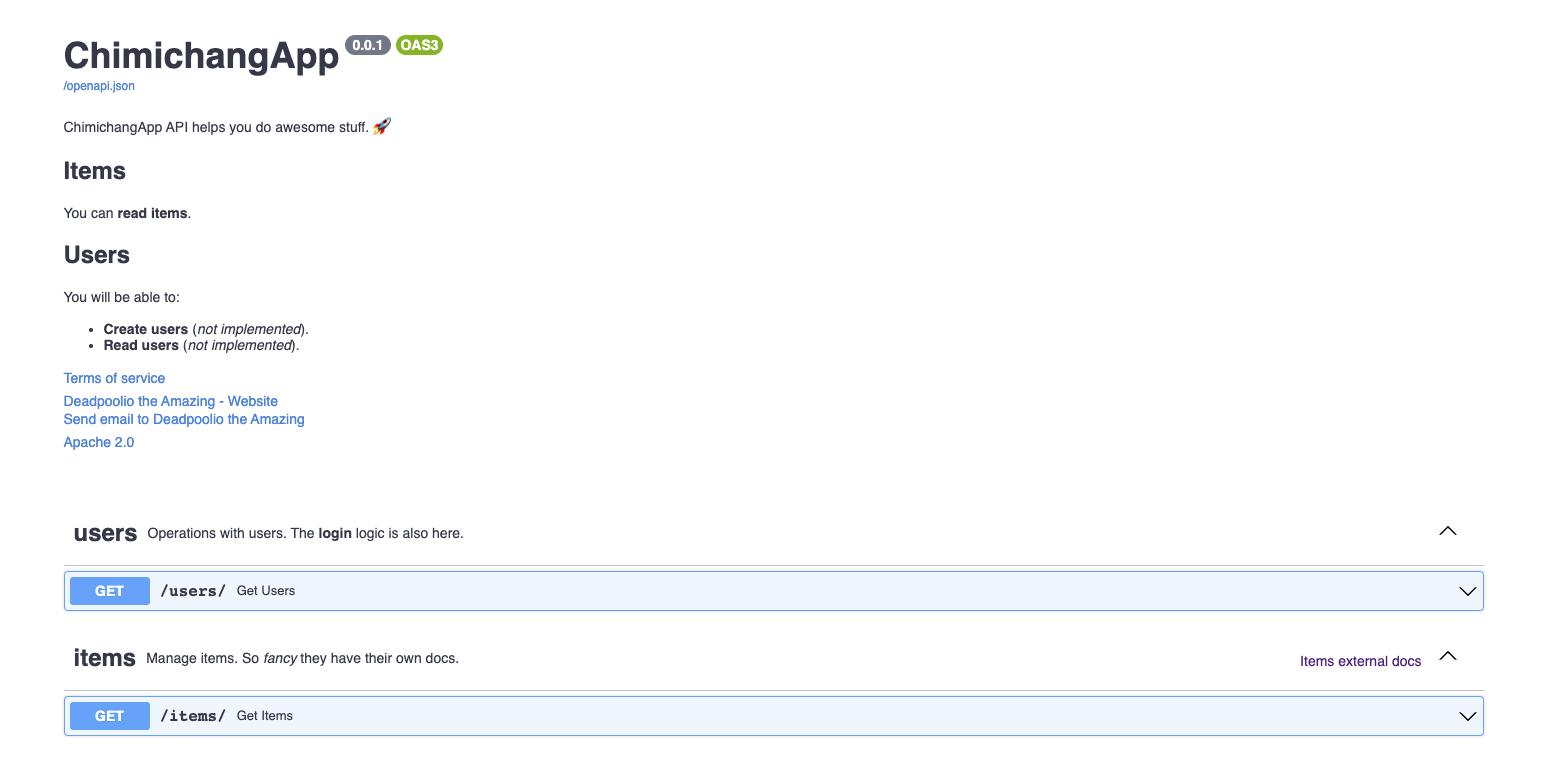
Static Files
# app_static / main.py
# Created by azat at 8.12.2022
from fastapi import FastAPI
from fastapi.staticfiles import StaticFiles
app = FastAPI()
app.mount("/static", StaticFiles(directory="static"), name="static")
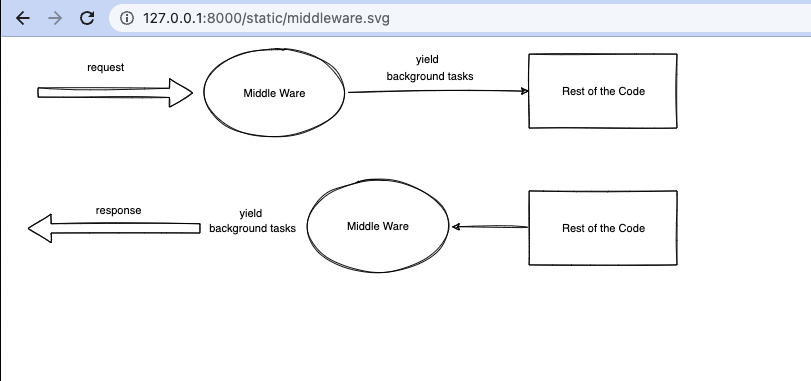
SQLModel
# sqlm / main.py
# Created by azat at 9.12.2022
from typing import Optional
from fastapi import FastAPI, HTTPException, Query, Depends
from sqlmodel import Field, Relationship, Session, SQLModel, create_engine, select
# =========== Team Models ============
class TeamBase(SQLModel):
name: str = Field(index=True)
headquarters: str
class Team(TeamBase, table=True):
id: int | None = Field(default=None, primary_key=True)
heroes: list["Hero"] = Relationship(back_populates="team")
class TeamCreate(TeamBase):
pass
class TeamRead(TeamBase):
id: int
class TeamUpdate(SQLModel):
name: str | None = None
headquarters: str | None = None
# =========== Hero Models ============
class HeroBase(SQLModel):
name: str = Field(index=True, unique=True)
secret_name: str
age: int | None = Field(default=None, index=True)
team_id: int | None = Field(default=None, foreign_key="team.id")
class Hero(HeroBase, table=True):
id: int | None = Field(default=None, primary_key=True)
team: Team | None = Relationship(back_populates="heroes")
# class Hero(SQLModel, table=True):
# # because this same SQLModel object is not only a Pydantic model instance but also a SQLAlchemy model instance,
# # we can use it directly in a session to create the row in the database.
# id: int | None = Field(default=None, primary_key=True)
# name: str = Field(index=True)
# secret_name: str
# age: int | None = Field(default=None, index=True)
# class HeroCreate(SQLModel):
# name: str
# secret_name: str
# age: int | None = None
class HeroCreate(HeroBase):
pass
# class HeroRead(SQLModel):
# id: int
# name: str
# secret_name: str
# age: int | None = None
class HeroRead(HeroBase):
id: int
class HeroUpdate(SQLModel):
name: str | None = None
secret_name: str | None = None
age: int | None = None
team_id: int | None = None
# =========== Models with Relationship ===========
class HeroReadWithTeam(HeroRead):
# The HeroReadWithTeam inherits from HeroRead, which means that it will have the normal fields for reading,
# including the required id that was declared in HeroRead.
# And then it adds the new field team, which could be None, and is declared with the type TeamRead
# with the base fields for reading a team.
team: TeamRead | None = None
class TeamReadWithHeroes(TeamRead):
# Then we do the same for the TeamReadWithHeroes, it inherits from TeamRead, and declares the new field heroes,
# which is a list of HeroRead.
heroes: list["HeroRead"] = []
sqlite_file_name = "simple_hero.db"
sqlite_url = f"sqlite:///{sqlite_file_name}"
connect_args = {"check_same_thread": False}
engine = create_engine(sqlite_url, echo=True, connect_args=connect_args)
def create_db_and_tables():
SQLModel.metadata.create_all(engine)
def get_session():
with Session(engine) as session:
yield session
app = FastAPI()
@app.on_event("startup")
def on_startup():
create_db_and_tables()
# =========== Team Endpoints ============
@app.post("/teams/", response_model=TeamRead)
def create_team(*, session: Session = Depends(get_session), team: TeamCreate):
db_team = Team.from_orm(team)
session.add(db_team)
session.commit()
session.refresh(db_team)
return db_team
@app.get("/teams/", response_model=list[TeamRead])
def read_teams(
*,
session: Session = Depends(get_session),
offset: int = 0,
limit: int = Query(default=100, lte=100),
):
teams = session.exec(select(Team).offset(offset).limit(limit)).all()
return teams
@app.get("/teams/{team_id}", response_model=TeamReadWithHeroes)
def read_team(*, team_id: int, session: Session = Depends(get_session)):
team = session.get(Team, team_id)
if not team:
raise HTTPException(status_code=404, detail="Team not found")
return team
@app.patch("/teams/{team_id}", response_model=TeamRead)
def update_team(
*,
session: Session = Depends(get_session),
team_id: int,
team: TeamUpdate,
):
db_team = session.get(Team, team_id)
if not db_team:
raise HTTPException(status_code=404, detail="Team not found")
team_data = team.dict(exclude_unset=True)
for key, value in team_data.items():
setattr(db_team, key, value)
session.add(db_team)
session.commit()
session.refresh(db_team)
return db_team
@app.delete("/teams/{team_id}")
def delete_team(*, session: Session = Depends(get_session), team_id: int):
team = session.get(Team, team_id)
if not team:
raise HTTPException(status_code=404, detail="Team not found")
session.delete(team)
session.commit()
return {"ok": True}
# @app.post("/heroes/", response_model=HeroRead)
# def create_hero(hero: HeroCreate):
# with Session(engine) as session:
# db_hero = Hero.from_orm(hero)
# session.add(db_hero)
# session.commit()
# session.refresh(db_hero)
# return db_hero
@app.post("/heroes/", response_model=HeroRead, status_code=201)
def create_hero(*, session: Session = Depends(get_session), hero: HeroCreate):
# Python would normally complain about that, but we can use the initial "parameter" *,
# to mark all the rest of the parameters as "keyword only", which solves the problem.
db_hero = Hero.from_orm(hero)
db_team_id = db_hero.team_id
if db_team_id:
db_team = session.get(Team, db_team_id)
if not db_team:
raise HTTPException(status_code=404, detail="Team not found")
session.add(db_hero)
session.commit()
session.refresh(db_hero)
return db_hero
@app.get("/heroes/", response_model=list[Hero])
def read_heroes(
*,
session: Session = Depends(get_session),
offset: int = 0, limit: int = Query(default=100, lte=100)):
heroes = session.exec(select(Hero).offset(offset).limit(limit)).all()
return heroes
@app.get("/heroes/{hero_id}", response_model=HeroReadWithTeam)
def read_hero(
*,
session: Session = Depends(get_session),
hero_id: int):
hero = session.get(Hero, hero_id)
if not hero:
raise HTTPException(status_code=404, detail="Item mot Found")
return hero
@app.patch("/heroes/{hero_id}", response_model=HeroRead)
def update_hero(*,
session: Session = Depends(get_session),
hero_id: int, hero: HeroUpdate):
# hero_id the hero id to update
# we read the hero from database by the provided id
hero_db = session.get(Hero, hero_id)
if not hero_db:
# checking if it exists, possibly raising an error for the client if it doesn't exist
raise HTTPException(status_code=404, detail="Item mot Found")
hero_data = hero.dict(exclude_unset=True)
# Now that we have a dictionary with the data sent by the client, we can iterate for
# each one of the keys and the values, and then we set them in the database hero model db_hero using setattr().
for key, value in hero_data.items():
setattr(hero_db, key, value)
session.add(hero_db)
session.commit()
session.refresh(hero_db)
return hero_db
@app.delete("/heroes/{hero_id}")
def delete_hero(
*,
session: Session = Depends(get_session),
hero_id: int):
hero_db = session.get(Hero, hero_id)
if not hero_db:
raise HTTPException(status_code=404, detail="Item mot Found")
session.delete(hero_db)
session.commit()
return {"status": "success"}
